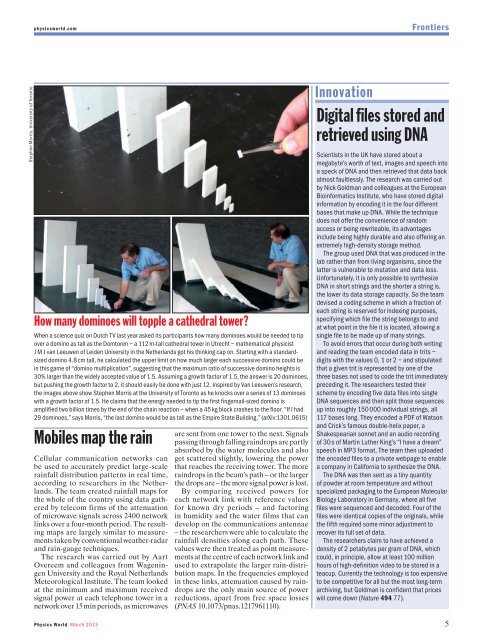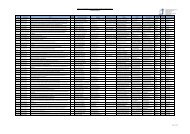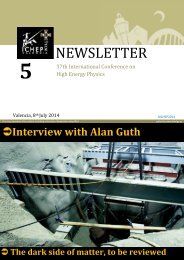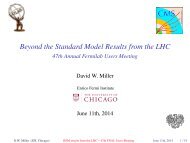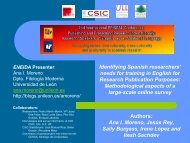PW_mar13_sample_issue
PW_mar13_sample_issue
PW_mar13_sample_issue
You also want an ePaper? Increase the reach of your titles
YUMPU automatically turns print PDFs into web optimized ePapers that Google loves.
Stephen Morris, University of Toronto<br />
physicsworld.com Frontiers<br />
How many dominoes will topple a cathedral tower?<br />
When a science quiz on Dutch TV last year asked its participants how many dominoes would be needed to tip<br />
over a domino as tall as the Domtoren – a 112 m-tall cathedral tower in Utrecht – mathematical physicist<br />
J M J van Leeuwen of Leiden University in the Netherlands got his thinking cap on. Starting with a standardsized<br />
domino 4.8 cm tall, he calculated the upper limit on how much larger each successive domino could be<br />
in this game of “domino multiplication”, suggesting that the maximum ratio of successive domino heights is<br />
30% larger than the widely accepted value of 1.5. Assuming a growth factor of 1.5, the answer is 20 dominoes,<br />
but pushing the growth factor to 2, it should easily be done with just 12. Inspired by Van Leeuwen’s research,<br />
the images above show Stephen Morris at the University of Toronto as he knocks over a series of 13 dominoes<br />
with a growth factor of 1.5. He claims that the energy needed to tip the first fingernail-sized domino is<br />
amplified two billion times by the end of the chain reaction – when a 45 kg block crashes to the floor. “If I had<br />
29 dominoes,” says Morris, “the last domino would be as tall as the Empire State Building.” (arXiv:1301.0615)<br />
Mobiles map the rain<br />
Cellular communication networks can<br />
be used to accurately predict large-scale<br />
rainfall distribution patterns in real time,<br />
according to researchers in the Netherlands.<br />
The team created rainfall maps for<br />
the whole of the country using data gathered<br />
by telecom firms of the attenuation<br />
of microwave signals across 2400 network<br />
links over a four-month period. The resulting<br />
maps are largely similar to measurements<br />
taken by conventional weather-radar<br />
and rain-gauge techniques.<br />
The research was carried out by Aart<br />
Overeem and colleagues from Wageningen<br />
University and the Royal Netherlands<br />
Meteorological Institute. The team looked<br />
at the minimum and maximum received<br />
signal power at each telephone tower in a<br />
network over 15 min periods, as microwaves<br />
are sent from one tower to the next. Signals<br />
passing through falling raindrops are partly<br />
absorbed by the water molecules and also<br />
get scattered slightly, lowering the power<br />
that reaches the receiving tower. The more<br />
raindrops in the beam’s path – or the larger<br />
the drops are – the more signal power is lost.<br />
By comparing received powers for<br />
each network link with reference values<br />
for known dry periods – and factoring<br />
in humidity and the water films that can<br />
develop on the communications antennae<br />
– the researchers were able to calculate the<br />
rainfall densities along each path. These<br />
values were then treated as point measurements<br />
at the centre of each network link and<br />
used to extrapolate the larger rain-distribution<br />
maps. In the frequencies employed<br />
in these links, attenuation caused by raindrops<br />
are the only main source of power<br />
reductions, apart from free space losses<br />
(PNAS 10.1073/pnas.1217961110).<br />
Innovation<br />
Digital files stored and<br />
retrieved using DNA<br />
Scientists in the UK have stored about a<br />
megabyte’s worth of text, images and speech into<br />
a speck of DNA and then retrieved that data back<br />
almost faultlessly. The research was carried out<br />
by Nick Goldman and colleagues at the European<br />
Bioinformatics Institute, who have stored digital<br />
information by encoding it in the four different<br />
bases that make up DNA. While the technique<br />
does not offer the convenience of random<br />
access or being rewriteable, its advantages<br />
include being highly durable and also offering an<br />
extremely high-density storage method.<br />
The group used DNA that was produced in the<br />
lab rather than from living organisms, since the<br />
latter is vulnerable to mutation and data loss.<br />
Unfortunately, it is only possible to synthesize<br />
DNA in short strings and the shorter a string is,<br />
the lower its data storage capacity. So the team<br />
devised a coding scheme in which a fraction of<br />
each string is reserved for indexing purposes,<br />
specifying which file the string belongs to and<br />
at what point in the file it is located, allowing a<br />
single file to be made up of many strings.<br />
To avoid errors that occur during both writing<br />
and reading the team encoded data in trits –<br />
digits with the values 0, 1 or 2 – and stipulated<br />
that a given trit is represented by one of the<br />
three bases not used to code the trit immediately<br />
preceding it. The researchers tested their<br />
scheme by encoding five data files into single<br />
DNA sequences and then split those sequences<br />
up into roughly 150 000 individual strings, all<br />
117 bases long. They encoded a PDF of Watson<br />
and Crick’s famous double-helix paper, a<br />
Shakespearian sonnet and an audio recording<br />
of 30 s of Martin Luther King’s “I have a dream”<br />
speech in MP3 format. The team then uploaded<br />
the encoded files to a private webpage to enable<br />
a company in California to synthesize the DNA.<br />
The DNA was then sent as a tiny quantity<br />
of powder at room temperature and without<br />
specialized packaging to the European Molecular<br />
Biology Laboratory in Germany, where all five<br />
files were sequenced and decoded. Four of the<br />
files were identical copies of the originals, while<br />
the fifth required some minor adjustment to<br />
recover its full set of data.<br />
The researchers claim to have achieved a<br />
density of 2 petabytes per gram of DNA, which<br />
could, in principle, allow at least 100 million<br />
hours of high-definition video to be stored in a<br />
teacup. Currently the technology is too expensive<br />
to be competitive for all but the most long-term<br />
archiving, but Goldman is confident that prices<br />
will come down (Nature 494 77).<br />
Physics World March 2013 5


